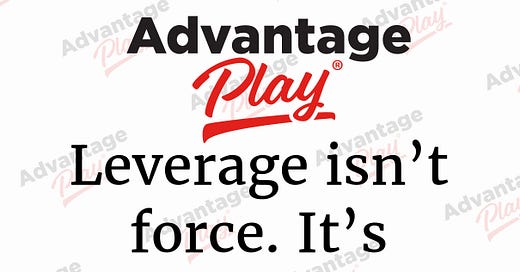Leverage Isn’t What You Think: How to Unlock Assets Nobody’s Betting On
Leverage isn’t force. It’s position. Find it.
Every Advantage Player® knows the difference between pushing harder and pushing smarter. Finding leverage isn’t about squeezing more out of the same old system - it’s about seeing what others don’t, so you can do what they can’t. In business, most people look for leverage in the obvious spots: debt, discounts, or a few more hires. But the killer plays come from finding unconventional leverage - assets hiding in plain sight, structures no one thought to unlock, and mental models that change the math. Wall Street doesn't run on hard work. It runs on leverage. And the right play can multiply force without multiplying risk. That’s what this Winning Hand™ is all about.
1. Press to Test: Ask Higher-Value Questions
If you’re still asking, “How can we grow faster?” you’re playing at the low-stakes table. High-limit questions are designed to press the system and surface hidden leverage. Ask: “What asset do we have that is undervalued by us but strategic to someone else?” or “What structure would change the game entirely if we dared to try it?” That’s how one industrial services firm turned their equipment inventory into a financeable leasing company, creating a recurring revenue stream out of yesterday’s depreciation expense. The asset didn’t change. The thinking did.
2. Read the Deck: Predictive Logic for Non-Obvious Multipliers
Pattern recognition is a killer edge. Leverage often hides in lagging indicators that lead to outsized wins. A regional food distributor noticed their most profitable customers weren’t the biggest spenders - they were the ones who called in fewer complaints and needed fewer deliveries. Instead of scaling sales, they scaled “easy-to-serve” client acquisition. That predictive logic created a new customer avatar that flipped their hiring, pricing, and bonus models. Leverage came from lowering service friction, not increasing volume. Most people miss these signals. Advantage Players® read the deck and play accordingly.
3. Eyes Everywhere: Strategic Optionality in Entity Design
Real estate is a good example. Everyone wants to leverage it, but overleveraging is a rookie move. The real leverage comes when you place it inside a purpose-built entity - then list the entity, not just borrow against the property. That play can turn a 3x real estate multiple into a 50-100x capital market event. We saw a manufacturing company spin out its owned facilities into a REIT, then lease them back at fair market value. The result? Tax-advantaged liquidity, balance sheet strength, and a stock kicker. Leverage wasn’t about the asset - it was the wrapper.
4. Split or Stay: Knowing When to Separate or Hold Tight
Some companies try to scale everything together - product lines, markets, people. But leverage often comes from splitting your hand. A multi-service SaaS firm split their enterprise and SMB businesses into two brands, with two sales motions. Suddenly each team could tune to its natural cadence, pricing logic, and CAC/LTV structure. Each brand became easier to finance, acquire, and grow. You don’t always need to add more. Sometimes you need to split what you have to unlock dormant value.
5. Doubling Down: People as Leverage Points
Most leaders think they need more people. Advantage Players® ask: “Who are the few who create the most future?” We’ve seen companies double down on high producers by investing in surgical skill development and eliminating administrative noise. One client took their top 5% of performers and built a “Micro-Firm” around them, stripping away red tape and providing dedicated support. Output didn’t double - it tripled. Leverage isn’t just headcount. It’s who you bet on and what you take off their plate.
6. Beat the Bust: Emotional Discipline and Strategic Restraint
Chasing leverage can trigger a form of addiction. Bigger bets, faster moves, thinner margins. But leverage used poorly amplifies both gains and stupidity. Emotional mastery keeps leaders from making desperation plays. One CEO was offered a juicy private equity recap with aggressive earnouts - he walked. Instead, he focused on internal financing via customer pre-pays and vendor float. Less sexy, more control, higher margin. Discipline beats drama. Every time.
7. Fast 5: High-Impact Actions
Identify one overlooked asset you control that could be restructured into a different form of value.
Ask three High Limit Questions at your next leadership meeting that challenge core assumptions.
Map your customer base by cost-to-serve and look for leverage in servicing ease, not spend.
Audit your org chart for “Leverage Creators” - then remove blockers and distractions around them.
Revisit your corporate structure with an eye toward public market optionality, licensing models, or spinouts.
Conclusion: Play Smarter, Not Harder
The best Advantage Plays® aren’t about working more hours, adding more bodies, or borrowing more money. They’re about using your mind to create multiplier effects from what you already have. Leverage isn’t about force - it’s about position. When you find the right angle, you don’t need to push hard to win big. Play to win. Don't bet blind.
What’s one unconventional source of leverage your team is ignoring right now?
Move the Needle
Want a cage-rattling, mind-bending keynote that wakes up your group, gets them thinking different, and sets them on the track to becoming Advantage Players® - people who play to win, not just play around? Call Joel.
Our Winning Hands™ series exposes killer strategies - Advantage Plays® - that elite performers use to get ahead and stay ahead. Drawn from the worlds of card counting and Wall Street, these calculated moves leverage approaches such as predictive logic, situational intelligence, and the nerve to press when the odds are in our favor. Straight from the Advantage Player® Institute's Red Chip program where our members learn to harness controlled aggression, adaptability, sustained growth, risk management, and more. Are we right for one another? Find out by reaching out.



